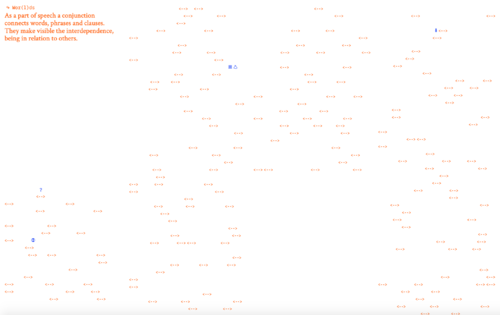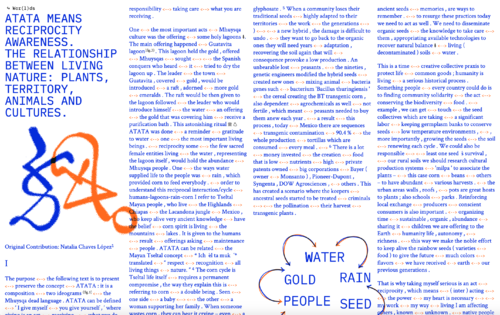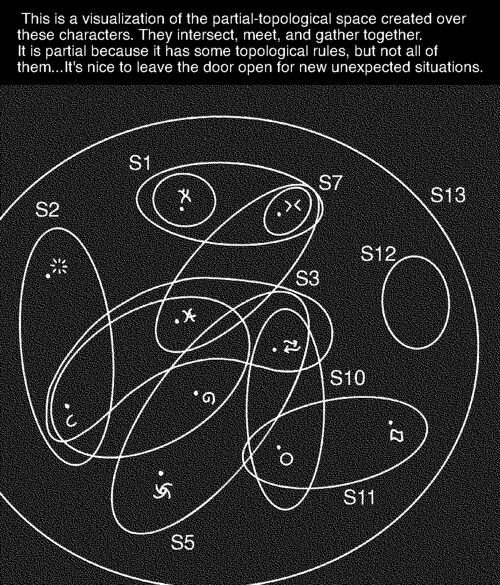User:Camilo/Final presentation: Difference between revisions
No edit summary |
No edit summary |
||
| Line 3: | Line 3: | ||
<div style="font-family: Alike Angular;">__TOC__</div> | <div style="font-family: Alike Angular;">__TOC__</div> | ||
=<div style="font-family: Alike Angular;"> | =<div style="font-family: Alike Angular;">TODO?</div>= | ||
What are you gonna do in the exhibition? | What are you gonna do in the exhibition? | ||
How do you see it in the future? Example? | How do you see it in the future? Example? | ||
| Line 25: | Line 14: | ||
=<div style="font-family: Alike Angular;">First Year?</div>= | =<div style="font-family: Alike Angular;">First Year?</div>= | ||
'''Special Issue · 1''' | =='''Special Issue · 1'''== | ||
: Re-publishing essays. | : Re-publishing essays. | ||
: Atata, the essay written by Natalia Chavez. | : Atata, the essay written by Natalia Chavez. | ||
| Line 33: | Line 23: | ||
URL: https://issue.xpub.nl/13/ATATA/ | URL: https://issue.xpub.nl/13/ATATA/ | ||
'''Special Issue · 2''' | [[File:Home13_Camilo.png|500px]] | ||
[[File:web13_1Camilo.png|500px]] | |||
=='''Special Issue · 2'''== | |||
: Small tools and game dynamics in publishing | : Small tools and game dynamics in publishing | ||
: Partial-topological space. Used bitsy, javascript, and drawing. | : Partial-topological space. Used bitsy, javascript, and drawing. | ||
| Line 46: | Line 38: | ||
'''Special Issue · 3''' | '''Special Issue · 3''' | ||
: Radio Implicancies: Diffraction. | : Radio Implicancies: Diffraction. | ||
:: * Questioning the concept of reflection. | :: * Questioning the concept of reflection. | ||
Revision as of 11:38, 6 June 2022
⚐. Final Presentation
TODO?
What are you gonna do in the exhibition? How do you see it in the future? Example?
Where from?
Coming from a background in visual arts and printed matter, my first approach to a publishing practice was the idea of the book. Since I was a child, the book has been the magic carrier where things come to life. I've always enjoyed its materiality and its ability to unveil thoughts and digest emotions from page to page. However, I comprehended by experience that publishing goes beyond this object and there is a vast world of formats, materials, tools and processes besides the codex. Publishing practices today sit in a post-digital era where malleability and complexity constantly expand and contract in new shapes and forms. From paper to screen, from t-shirts to radio, in essence, every publication becomes from the mere act of making public.
First Year?
Special Issue · 1
- Re-publishing essays.
- Atata, the essay written by Natalia Chavez.
- Atata: Reciporoicty awarness. Mapping words with drawing tools. Warming up with Python, HTML, CSS.
- * I used conjunctions as the key element that connects
- * Replace all the conjunctions with arrows that emphasize the relational aspect.
URL: https://issue.xpub.nl/13/ATATA/
Special Issue · 2
- Small tools and game dynamics in publishing
- Partial-topological space. Used bitsy, javascript, and drawing.
- It is a system of micro games that are connected between each other from
- * The structure of the game experiments with the idea of Topology and proposes a set of non-games that have intersections and unions.
between them.
- * Experiment on structures.
Special Issue · 3
- Radio Implicancies: Diffraction.
- * Questioning the concept of reflection.
- * What is diffraction? How do I relate with it....
Second Year
Attempting diffraction URL: Attempting diffraction is a pattern of different experiments that emerged from the question: How can publishing practices perform diffraction? Some experiments are towards myself but others are to other practicioners and readers.
Motivation My very first motivation to started the project was to gather and share the different processes tools, concepts and so that I learnt during the course. Comming from a pritted matter background, the discovery of different processes changed my own experience with publishing. And because I'm also starting the publishing project with Maria, I wanted to made ourselves a cookbook, toolbox, or magic bag for the present practice. And after thinking and gathering the first things I came up with the idea of the glossary. And then, due to the very nature of diffraction, it started to be one and multiple things, that shapeshift and transform.
Research Thesis.
- Permeable territories: between reflection and diffraction weaving a publishing practice.
- Questioning publishing territories through a diffractive lens.
- Understanding Diffraction.
- Subverting glossary structures.
- Sketching ideas for experiments.
Tools:
- * Using drawing as a research tool.
- * Exercise paged.js and web to print workflow.
File:Permeable-territories.jpg
A brief glossary of glossaries URL: https://hub.xpub.nl/sandbot/Camilo/a_brief_glossary/
- It was a workshop to understand glossary structures collectively.
- * Which things in glossaries were interesting to think.
- * Hierarchies, monolingual, written word predominantly.
"Permeable Glossary, a living publishing practice URL: https://hub.xpub.nl/sandbot/Camilo/Glossary/
- It is an on-going and ever evolving bag of words and resources of publishing. It questions glossaries' structure and performs relation-ability by being open to contribution and experiment with reading.
- * To gather resources of last year and expanding the research .
- * Start questioning reflection and the way I was doinig it.
- * As a first attempt to diffract by anotating and expanding.
- * To develop my own tools and create my own publishing system.
Rumination Sessions URL:
- These are workshops sessions to digest the current state of the glossary. These moments activate the "Permeable Glossary" and invites other practitioners to be part while sharing and conversing around it.
- * Explore Game dynamics.
- * We are using cards to invite participants to ask them selves questions and perfom relationships.
- * Every relationship uses a different card inspired by knots, interwovens, magic, intersection,
- * Pagedjs to print cards.
- * Practice collaboration.
- * Moment to circulate the glossary and invite to participate.
Living glossary environment URL:
- It is a tool to make living glossaries from a text file. It allows the creation of a static website that uses the idea of glossary as a layering of annotations rather than a closed list of words and definitions.
- * Working with flask, git repositories
- * An understanding of sharing tools while making tools
Dear reader URL:
- It is a letter and a micro application made in flask to gather and circulate questions. It feeds the "Rumination Sessions" were questions are cards that initiate reflection. But in the future it is already a living publication.
Questions of publishing URL:
- It is a tool that aims to introduce a diffractive thought inside publishing processes. It is a tool that helps practitioners to reflect and diffract about their projects by asking questions and triggering the use of the "Permeable Glossary".
- * Pedagogical understanding of diffraction inside the publishing practice
- * What is a reflective publishing practice?
- * How can diffraction add to it?
Autonomous Practices
- Started to build my own server and taking care of my infrastructures.
- getting comfortable and uncomfortable with languages, scripts, computers, routers, etc..



